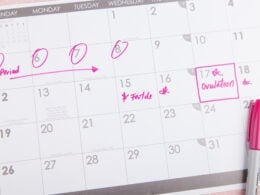Megan Faller knew she needed a break. She had co-founded a FertilityCare center and was a school teacher working in a very stressful classroom environment without any time for a pause in her hectic schedule. All of her obligations eventually became unsustainable and she decided she needed a break from it all. She had been struggling with an autoimmune issue and knew she needed to find a way to care for herself better amidst her work and family duties.
As a FertilityCare Practitioner trained in the Creighton Model, Megan knew the power that comes from understanding her cycle, so she began to research how to create a more sustainable self-care routine and she ran across some advice that suggested she take time to rest during her period. The idea made sense, so she tried it. Megan began to intentionally take several days during her period to lay low and simply relax. She found that she felt better afterward and actually had more energy going forward than she had in the past after her period.
This ‘aha’ event for Megan inspired her to learn more about how she could leverage the sociability, mood, and energy changes that naturally occur with her changing hormones throughout her cycle, something known as cycle syncing. Cycle syncing is the practice of eating, exercising and aligning your schedule with the different phases of your natural menstrual cycle. That way, you give your body the support and rest it needs, rather than pushing it to perform at the same high level at all times.
Megan’s research and her own personal success with cycle syncing eventually inspired her to help other women to understand how they can tune into the big hormone shifts they naturally experience so they can understand their mindsets, moods, and how to live a healthier, happier life. She developed a course called The Aligned Cycle, which teaches women how to use their natural and predictable hormone fluctuations to be more efficient, productive, and sustainable in their work and schedules.
Yes, your hormones are constantly changing—but it’s a feature of the female system, not a bug!
As a woman’s hormones change through her cycle, her mood and energy levels also shift. An understanding of what’s normal and what to expect next is not an excuse for women or girls to be crabby or moody, but a chance to embrace the natural ebb and flow of their moods and energy. A woman can learn to take advantage of when she feels more energetic and sociable, and give herself permission to withdraw when her mood is low.
Life becomes more manageable when we have self-awareness. This is especially true during potentially tumultuous times like puberty and postpartum.
Working with the four phases of your cycle
Though different cycle-syncing experts will have different names for the phases of the cycle, they broadly agree that there are four phases of a woman’s cycle to be mindful of when understanding hormonal shifts. I’ll use the terms that Megan uses in teaching women, as they describe quite well how to approach each phase.
Phase 1: “Rest and Retreat”
- When: The first 2-3 days of your period, which are also the first 2-3 days of a new cycle (some women may also want to include a few days before their periods start, i.e., the last few days of their previous cycle)
- What’s happening with your hormones: Estrogen and progesterone are low
- How to make the most of it: An emotional shift is normal as a woman starts her new period and she may feel like hibernating. It’s ok to relax, indulge, and take more time for yourself during your period. Schedule time to recharge and give yourself the flexibility to forgo extra meetings and obligations. Bonus! During this time of low hormone levels, your left and right brains are communicating more efficiently, heightening your analytical and intuitive reasoning. This is a great time to reflect on your past month, re-evaluate your work, relationship, and personal goals, and consider whether your course aligns with your vision.
Phase 2: “Ease in and Ramp Up”
- When: Approximately day 3 of your cycle until a few days before ovulation (i.e., most of what is known as the follicular phase)
- What’s happening with your hormones: Estrogen is rising and is the dominant hormone
- How to make the most of it: As your period finishes up and your cycle progresses toward ovulation, you feel ready to get back into work, but it’s alright to ease back into your work routine. As estrogen rises, your creativity will also increase, and this is a good time to start new projects, plan, strategize, and brainstorm. You are open and ready to try new things.
Phase 3: “Connect and Be Seen”
- When: the 3 days leading up to and including ovulation
- What’s happening with your hormones: Estrogen and testosterone peak
- How to make the most of it: The spike of testosterone during the ovulatory phase makes women feel more energetic, optimistic, competitive and ready to push toward goals. Your brain chemistry during this phase heightens your verbal skills, so this is a great time to connect with people and have important conversations. Though women generally feel really empowered during phase 3 of their cycle, it’s important to be mindful of the tendency to also be easily distracted.
Phase 4: “Wrap Up and Nest”
- When: after ovulation until the day before menstruation (also known as the luteal phase)
- What’s happening with your hormones: Progesterone is rising and the dominant hormone. If a pregnancy doesn’t occur, hormone levels decrease before menstruation begins.
- How to make the most of it: During the luteal phase, women often feel a shift from energetic and outgoing to somber and introspective. They are ready to do more deep work and power through finishing projects and getting things done. During this time, women are at their most task-oriented, and find it easy to focus and pay attention to minute details. This is usually the longest single phase of the cycle.
Your body has its own rhythm—don’t let birth control be your conductor
Cycle syncing only works when you’re in natural cycles. Hormonal birth control like the pill, patch, or ring may give you a monthly withdrawal bleed which mimics a period, but your natural cycle of estrogen and progesterone fluctuations is being suppressed, so you won’t experience the mood, energy, and mental shifts that naturally cycling women do.
The first basic step to finding your own menstrual rhythm is to track your period along with journaling, and tracking your mood, energy, and productivity level on a calendar each day. This will allow you to see patterns that emerge over the course of your cycle, so you can begin to plan ahead for when you feel the most outgoing, most creative, and most focused. If you have a fairly regular cycle, this should work well.
If you have an irregular period or want the most predictability with cycle syncing, charting your cycle will be best. Cycle charting is different from period tracking because with charting, you’re making daily observations about your body (usually checking for cervical mucus and/or basal body temperature) and recording those on a chart. Your chart allows you to know when your estrogen is rising, when ovulation has happened, and when progesterone is rising–which is what allows women and couples to use charting for family planning as well. After a few months, you’ll begin to learn your personal pattern, and have the power to know what’s going on in your body and how to make the most of your strengths during each phase.
Of course, imbalanced hormones will make cycle syncing difficult, so if you have symptoms such as heavy bleeding, absent or irregular periods, PMS, extreme mood swings, or a difficulty in detecting ovulation (when charting), this is a sign from your body that something is wrong. If you experience any of these complications, it’s important to seek help from a restorative reproductive healthcare provider.
The idea behind cycle syncing is simple enough: While we’re used to planning our lives on a weekly and monthly basis, what about scheduling around your cycle? Admittedly, though, it can be difficult to put into practice. After all, women have been conditioned to gracefully adjust to a man’s workplace, environment, schedule, and approach to productivity. But learning to sync your female hormonal cycle with your work and life schedule is the ultimate hack to help you take advantage of your natural female genius.
Additional Reading:
Dipping Your Toes Into Fertility Awareness Via Mood Tracking
Natural Womanhood Book Review: In the Flo by Alisa Vitti
Cycle mindfulness: What happens when you teach fertility awareness to teen girls
How Mindfulness Can Improve Your Charting Habits
New Book Explores How Hormonal Birth Control Affects Women’s Brains
5 Ways Stress Can Affect Your Period and the Rest of Your Cycle











